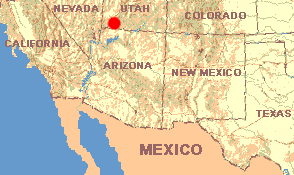 March 31, 1988
March 31, 1988UTAH: mostly Washington County
Along the Virgin River To Zion National Park
 March 31, 1988
March 31, 1988Having planned to stay at least a couple of days along Lake Mead this morning I awaken with the urge to move on. It's the wind. For more days than I can think back through the wind has rocked Henry wherever we parked. It's made sandgrains sweep ever eastward, and its personal beating sounds about my ears have filled me with restlessness. The moon, growing full now, fills the nights with dreams that in the morning find me curled inside my sleeping bag terrified and humbled.
Northeastward, then, on I-15, out of Nevada and for an hour or so across the extreme northwestern corner of Arizona, through the steep-walled canyon of the Virgin River where the uncommon dimensions and wild forms of red-rock canyon walls do the river-water's rumbling and cursing and praying for it, since you cannot hear the water speaking from inside the car. Climbing, climbing, climbing, then finally we break over the side of the plateau and there's St. George, Utah, elevation 2880, with Guardian Angel Peak behind it rising to 7160 feet.
For over an hour as we move toward, pass through and then roll out of St. George, I cannot take my eyes from Guardian Angel Peak. Rising steeply to a zone in the sky where gray and brooding clouds hang all about, this mountain out-Olympuses Olympus. From those anxious, pregnant, dark clouds clustered around the peak, gray curtains of cold rain continuously sweep downward like opaque veils hung all around, extending no farther into reality than the mountain's outer flanks. All the time I watch these curtains do not part or withdraw, though they do slowly and majestically sway, as if moved by Zeus's breaths.
We leave I-15 and head eastward, back toward Kentucky, perhaps, on UT Hwy. 9. Virgin, Grafton, Rockville and Springdale are towns along the Virgin River, which we follow as it climbs. Unlike all the previous desert towns we've been through these remind me of Western Kentucky towns. Here lawns and pastures are not brown or irrigated, but rained on enough to be gloriously Easter-morning green, all punctuated with exuberant yellow Dandelions. Along paths leading to homes' front doors and at the edges of garages grow yellow Daffodils and, at house corners, yellow Forsythias, all heaving mightily in the wet-feeling, blustery and cold wind. Here men wear heavy, plaid coats and seed-company caps as they do in Kentucky at this season. Until their pickup-truck engines warm up, gray fog-smoke curls from exhaust pipes into the raw air. No: I've seen nothing like this in any of those three previous deserts.
My books indicate that now we are in the southeastern corner of our fourth and last desert, the Great Basin Desert. But here on the Virgin River's canyon floor, there's not a hint of desert. Not a hint, unless you look behind the houses. There, where back lots end, mostly bare, rusty-red sandstone rises vertically, surrealistically, to the mesa's edge above. Desert must be up there.
Suddenly a booth appears in the middle of Utah Hwy. 9 and a young woman in a ranger uniform asks for five dollars; I'm entering Zion National Park whether I want to or not, and that costs five bucks, even if you consider yourself as only using Highway 9, heading to Kentucky.
Knowing absolutely nothing about Zion, but having paid my fee, I stop at the Visitor Center, situated at exactly 4000 feet above sea level. At noon on a Thursday the place is swarming. I hear Italian, German, Spanish and a host of U.S. accents; Greyhound buses with AMERICA displayed in their destination windows fill one corner of the parking lot, their engines idling contentedly. Zion has some good backpacking trails, I find, but most still are snowed under. I ask for a three-day permit for the southeastern corner, which is lower in elevation than the rest.
The drive to the East Entrance Trailhead passes through the most thrillingly colorful, rugged and heart-stopping terrain Henry and I ever have seen. Always rising in elevation, we sail through the view finders of at least twenty home-video cameras. In five miles we pass five different tourists standing on their cars photographing peaks above them. Of course, with such distances and elevations, it makes no difference at all whether a picture-taker stands on a car or on the ground beside it. However, something in this landscape makes you feel the need to be atop something as you're relating to these peaks. I'm gratified to see so many people unconsciously expressing soaring head-sets.
The trailhead parking lot lies at 5700 feet. Wind here is keen and mean-spirited and small drifts of snow lie here and there. Tall pines fill the valley before me. Though it does not look deserty here, my books say that we're well within the boundaries of the Great Basin Desert. In contrast to the first hours in our other three deserts, I have a hard time getting a fix on where I am and what this land is doing.